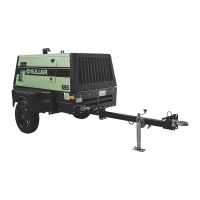Section 1
SAFETY
1
1.1 GENERAL
Sullair Corporation designs and manufactures all
of its products so they can be operated safely .
However, the responsibility for safe operation rests
with those who use and maintain these products.
The following safety precautions are offered as a
guide which, if conscientiously followed, will mini-
mize the possibility of accidents throughout the
useful life of this equipment. Read the CIMA Safety
Manual prior to compressor operation and towing,
if applicable in your area.
The air compressor should be operated only by
those who have been trained and delegated to do
so, and who have read and understood this Opera-
tor’s Manual. F ailure tofollow the instructions, pro-
cedures and safety precautions in this manual can
result in acci dents and injuries.
NEVER
start the air compressor unless it is safe to
doso.
DONOT
attempt to operatethe aircompres-
sor with a known unsafe condition. Tagthe aircom-
pressor and render it inoperative by disconnecting
the battery so others who may not know of the un-
safe condition will not attempt to operate it until the
condition is corrected.
Use and operate the air compressor only in full
compliance with all pertinent OSHA requirements
and/or all pertinent Federal, State and Local codes
or requirements.
DO NOT
modify the compressor except with writ-
ten factory approval.
Each day walk around the air compressor and in-
spect for leaks, loose or missing parts, damaged
parts or parts out ofadjustment. Perform all recom-
mended daily maintenance.
Inspect for torn,frayed, blistered orotherwise dete-
riorated and degraded hoses. Replace as re-
quired.
NOTE
Estimated hose life based on a 5 --- day 8 --- hour
work week is 3 years. These conditions exist on
an 8---hour shift only. Any other operation of the
equipment other than 8---hour shifts would short-
en the hose life based on hours of operation.
1.2 TOWING
(I)
A. PREPARING TO TOW
WARNING
!
DO NOTtowthecompressor shoulditsweightex-
ceed theratedlimit of the tow vehicle, as thevehi-
cle may not
brake safely with excess weight. See
rated limit in tow vehicle Operator’s Manual, and
reviewitsinstructions andother requirements for
safe towing.
1. Prior to hitching the air compressor to the tow
vehicle, inspect all attachment parts and equip-
ment, checking for (i) signs of excessive wear or
corrosion, (ii) parts that are cracked, bent,
dented orotherwise deformed ordegraded, and
(iii) loose nuts, bolts or other fasteners. Should
any such condition be present,
DO NOT TOW
until the problem is corrected.
2. Back the tow vehicle to the compressor and
position it in preparation for coupling the com-
pressor.
3. If the compressor is provided with a drawbar
latched in the vertical upright position, carefully
unlatch drawbar and lower it to engage the cou-
pling device. If not, raise drawbar to engage
coupling device or otherwise couple the com-
pressor to the towing vehicle.
WARNING
!
This equipment may be tongue heavy. DO NOT
attempt to raise or lower the drawbar by hand if
the weight is more than you can safely handle.
Use the screw jack provided or a chain fall ifyou
cannot lift or lower it without avoiding injury to
yourself orothers. Keep hands and fingers clear
ofthe coupling device and all other pinchpoints.
Keep feet clear ofdrawbar toavoid injuryincase
it should slip from your hands.
4. Make sure the coupling device is fully en-
gaged, closed and locked.
5. If chains are provided, pass each chain
through itspoint ofattachment onthetowing ve-
hicle; then hook each chain to itself by passing
the grab hook over (not through) a link. Cross
chains under front of drawbar before passing
them through points of attachment on towing
vehicle to support front of drawbar in case it
should accidentally become uncoupled.
6. Make sure that the coupling device and adja-
centstructures onthetowingvehicle (and also, if
utilized, chain adjustment, brake and/or electri-
cal interconnections)
DO NOT
interfere with or
restrict motion of any part ofthe compressor, in-
cluding its coupling device, with respect to the
towing vehicle when maneuvering over any an-
ticipated terrain.
7. If provided, make sure chain length, brake
and electrical interconnections provide suffi-
cient slack to prevent strain when corneri ng and
maneuvering, yet are supported so they cannot
dragorrub onroad,terrainortowing vehiclesur-
faces which might cause wear that could render
them inoperative.
WARNING
!
Retract the front screw jack only after attaching
the compressor to the tow vehicle. Raise the
screw jack to its full up position and pull the pin
connecting the jack to the drawbar. Rotate the
screw jack to its stowed position, parallel to the
drawbar, and reinsert the pin. Make sure thejack
is secured in place prior to towing.
If acaster wheelis provided on thescrewjack itis
part of the screw jack and can not be removed.
Follow the same procedure for stowing away the

